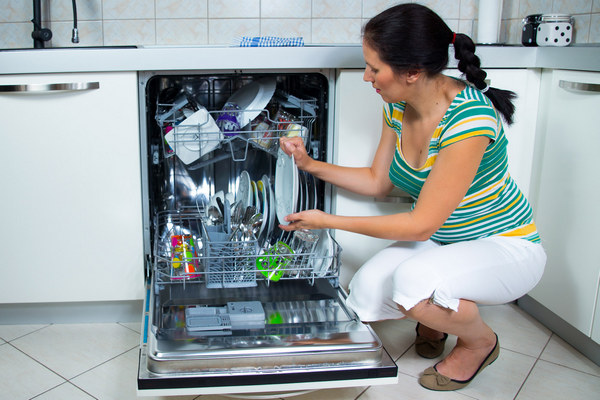Modern dishwasher detergents are of three main types: powder, liquid detergents (gels), and tablets. The latter are mostly available in a 3-in-1 format and contain detergent, rinse aid and salt to soften the water. When using a powder or gel, it is recommended to use salt and rinse aid additionally, by pouring or pouring them into the corresponding tanks.
Normally, the dishwasher easily draws from the dispenser and uses any type of detergent. But the situation when a dishwasher doesn’t spit out a tablet or stops taking detergent is very common and is familiar to almost every dishwasher owner. Let’s talk about why it happens in this article.
When it’s possible to solve the problem yourself
There are many reasons why the dishwasher does not rinse the tablet or powder. It is not uncommon for the dishwasher to pick up the detergent from the compartment, but it did not fully dissolve during the wash cycle, and you see pill or powder residue inside the dishwasher. If this is the first time this has happened, there is no need to panic. For starters, rule out the following situations related to the dishwasher’s operating rules.
Wet detergent compartment. If you see moisture in the detergent dispenser, you should first wipe the compartment with a paper towel, and only then put a tablet or powder. Otherwise, the detergent may stick to the compartment and will not be rinsed away by the water pressure.
Select a program without detergent. Make sure that you have selected the wash program. If “rinse dishes” was selected, no detergent will be drawn in. On short programs, some detergent may also remain in the dispenser.
Filter clogging. The water circulating during dishwashing goes through the filter system many times during the cycle. If they are clogged, the water pressure from the sprinklers decreases: as a consequence, the machine does not rinse or does not fully wash out the tablet, powder, and rinse aid. To avoid this problem, remember to clean the filters as they become dirty: one to several times a week, depending on how much you use the dishwasher.
Blocking the detergent compartment lid with dishes. If the dishes are not placed correctly,theyt can block the dispenser lid. As a result, the tablet compartment in the dishwasher will not open, the machine will not eject the tablet, and the wash goes on without the detergent. To avoid this situation, always place the dishes according to the recommendations in your dishwasher’s manual, do not overload the dishwasher.
Locking the detergent compartment lid with a tablet. In most dishwashers, the tablet must be placed horizontally in the compartment. Vertical or placed on the rib results in the lid clinging to the tablet and physically unable to open, as a consequence – the tablet does not fall out. Please refer to your dishwasher’s operating instructions for the correct placement of the tablet in your dishwasher.
Incorrect use of tablets. Some tablets have water-soluble packaging, others require the protective film to be removed. If you should have removed the packaging but have not done so, the tablet will not dissolve and will remain intact.
Troubleshooting
If you are sure that you have chosen the right program, the dishes have been placed correctly, the compartment for means was dry, filters are clean, means were used correctly, but the dishwasher still does not wash away the tablet or powder, it is most likely a malfunction. Such malfunctions are mainly related to the fact that water circulation in the machine is disturbed: due to low pressure, the product is not washed out or is only partially washed out of the compartment.
Nozzles of sprinklers are defective
At the ends of sprinklers there are nozzles – water comes out of them under pressure, at the expense of which there is a rotation of “beads”. The following problems can occur with the spray arms during operation.
Dirty nozzles. If the nozzles are clogged with grease, food particles, or limescale, the water circulation is impaired. The spray arms rotate slower than they should or do not rotate at all. The water flow does not reach the dispenser and the detergent does not flow into the dishwasher tank.
Dishwashing detergents or dishwasher cleaners are eating away at the nozzles. Detergents and detergents used to clean the dishwasher can corrode the nozzles over time. Due to the increased size of the holes, the pressure becomes weaker: the spray arms do not rotate or rotate at a slower speed than necessary. Due to reduced pressure,the dishwasher does not pick up tablets, powder, and/or rinse aid.
The gasket at the connection between the water supply duct and the spray arm is leaking
Because of this, the water partially or completely does not reach the impeller blad, but drains into the center of the basket. As a consequence, the dishwasher does not take tablets, powder, and rinse aid.
Clog in the water supply duct
The water supply to the sprinklers is through the channels – back, top, bottom, and under the basket. If there is a clog in them, the water cannot circulate properly through the machine: one or more sprinklers rotate slowly or do not rotate at all. The weak water pressure does not reach the detergent dispenser, and the detergents are not washed out.
Seal of the nut of the rear water supply channel to the sprinkler under the upper basket is leaking
Water enters the impeller under the upper basket through the under-basket channel. It connects to the rear channel with a grommet nut. Normally, when you push the basket all the way in and close the dishwasher door, the channels fit snugly together and water flows at the proper pressure into the sprinkler. If the seal is damaged, water runs down the back of the dishwasher, reaching only partially into the under-basket channel and impeller. Because of this, the pressure drops, and the sprinkler rotates weakly or does not rotate at all. Jets don’t reach the detergent tray, and the detergents are not washed out or not completely washed out.
The circulation pump is defective
It could be blocked: in this, case the water pressure is low and the dishwasher does not fully rinse out the detergent. If the pump is out of order, there is no water circulation at all, so the tablet is not emptied, the powder is not rinsed and the rinse aid is not consumed.
Water flow distributor is broken.
Normally, this mechanism is responsible for switching the water flow between sprinklers. If the actuator is “jammed” in the position of water supply to the lower impeller only, the water flow will not reach the detergent dispenser. As a consequence, the user sees that the dishwasher does not pick up the tablet, powder, and rinse aid.
Structurally, the water flow dispenser in the dishwasher is usually represented by a device consisting of a pair of discs (one of them with holes for adjusting the water flow) and a motor. Over time, the teeth of the discs or the gear that drives the discs wear out, so the mechanism stops rotating and the water only flows to one atomizer. The water flow distributor may also burn out due to moisture ingress through a leaking gland.
In dishwasher models where a magnetic valve is used to regulate the water flow, the water flow divider often burns out due to power surges.
The mechanism for opening the powder, tablet, or rinse aid compartment is broken.
The detergent dispenser mechanism usually fails, that is why the compartment does not open during washing and the detergent does not get into the tank.
Damaged wiring or contacts in powder, rinse aid, or tablet opening mechanism
Due to vibrations during the operation of the dishwasher, as well as moisture ingress, it is not uncommon for the contacts of the compartment opening mechanisms to become weak, oxidized, or burned out. Also, signal breakage can occur in the wiring from the control board to the dispenser.
Control box faulty
Burned-out tracks or broken elements on the board in the circuit of the circulation pump. It is not pumping water, the program does not reach the point where you need to open the hoppers for detergents. Most dishwashers interrupt the program with an error.
Damaged wiring or contacts in the circulation pump circuit
That’s why the pump doesn’t turn on. Signal breakage is often caused by vibrations during dishwasher operation: wiring is frayed, and contacts are loose. In private homes, it is not uncommon for rats or mice to chew through the wiring.
If your dishwasher is not picking up tablet, powder, or rinse aid and the quality of washing has become unsatisfactory. The best solution is to call a handyman at home or go to a service center. It is to call us and we will give you the best repair service AT ALL SAN DIEGO. We are open 24 hours a day, 7 days a week, on weekends and holidays. For urgent cases, our engineers will come to you 15 minutes after your call. Call us and SAN DIEGO APPLIANCE REPAIR will solve your problem.
Contact us
 619-928-5000
619-928-5000  Request Service
Request Service 
